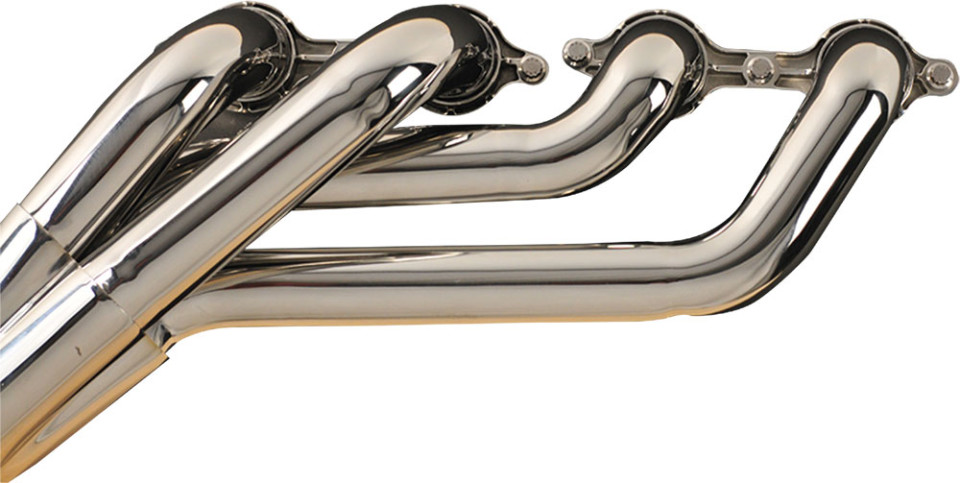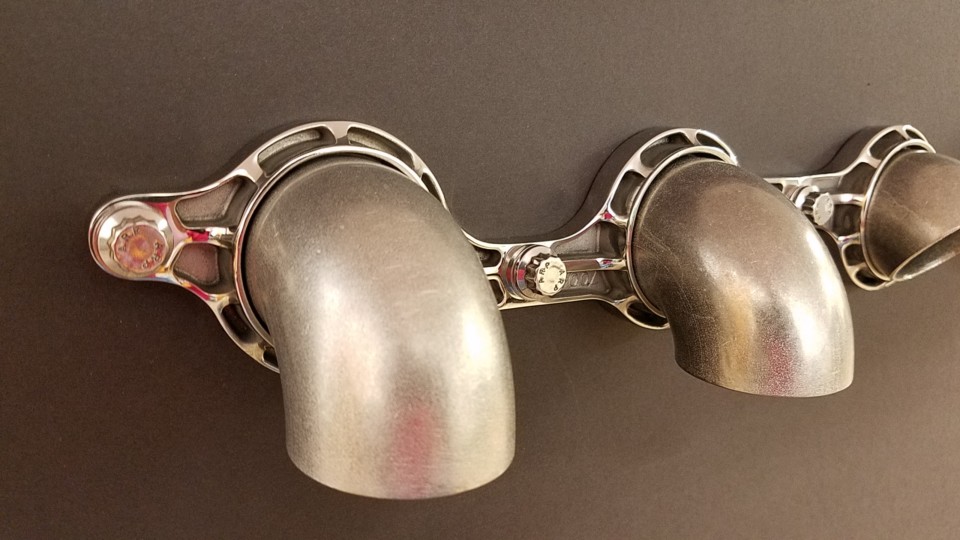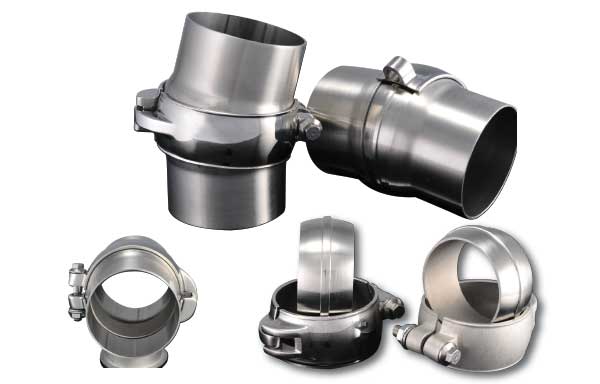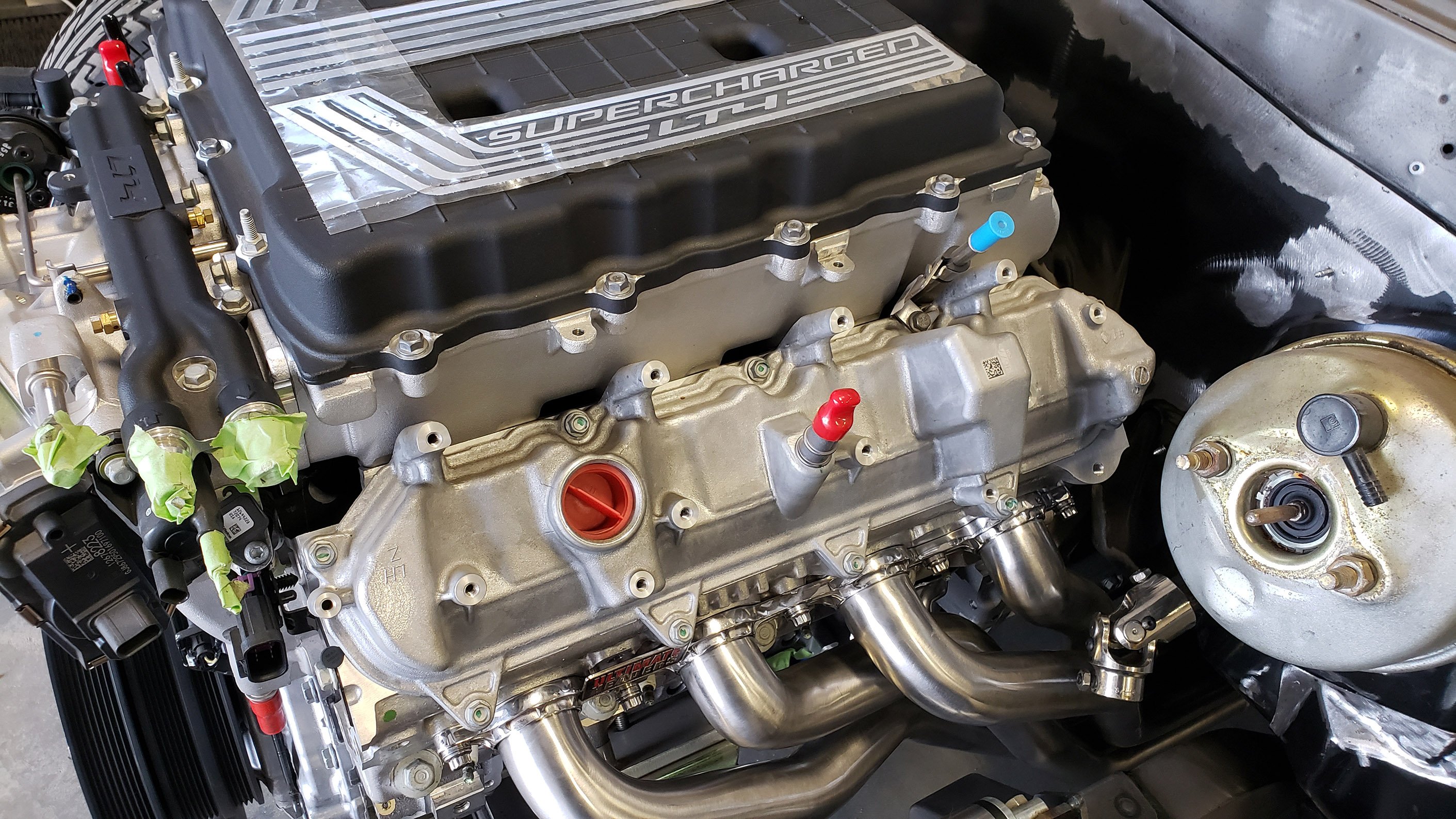Over the past few years, Ultimate Headers has earned a reputation as a company that isn’t satisfied by simply following the status quo. Established in 2012 in Berea, Ohio, the exhaust manufacturer is the brainchild of Corsa Performance founder Jim Browning, who sought to bring the same level of quality and innovation found in Corsa’s muffler designs to the then-stagnant header market.
“We have a saying around here that it’s the first header redesign in 80 years,” quips Jim Browning Jr. “Put 10 different headers side by side and they all look basically the same. We wanted to take a fresh approach to a product segment that, quite frankly, hasn’t changed much in decades. So when you put ours next to that lineup, you’ll see dramatic differences.”
Ultimate Headers took a holistic approach to the issue, considering ways to leverage emerging technologies in its products as well as new methods of manufacturing that would yield substantial benefits for all parties involved. Here we’ll take a closer look at how Ultimate Headers has used that strategy to bring innovation to header development, design, and production, and what those advancements mean for builders who demand components built to a higher standard.

Ultimate Headers’ debut product, the LS swap header seen here, was designed for street rods, custom cars, and classic trucks – chassis where clearance can be problematic when paired with a modern GM small-block. The unique aesthetic of these headers, along with the attention to detail given to their design and engineering, made them stand out among the various options available in that segment.
Engineering Form And Function
Even at the most fundamental level of design, Ultimate Headers has managed to set itself apart from the pack.
“We are the only manufacturer to build headers from 321 stainless steel on a production-type basis,” Browning notes. “Versus the 304 stainless steel that’s traditionally used in header manufacturing, 321 stainless is 50-percent stronger at 900-plus degrees Fahrenheit.”
Normally used by teams in Formula One, NASCAR, and pro-level endurance racing, this material has been proven to withstand the prolonged high-temperature stresses that are inherent to top-tier motorsport, and its bolstered resistance to thermal cracking also makes it a natural choice for high-horsepower turbo builds.

While similar, there are a few key differences between 304 stainless steel traditionally used for header production and the 321 stainless that Ultimate Headers uses. The latter’s additional carbon content increases its overall strength, while its titanium content improves the elevated temperature properties of the alloy, making it an ideal material to handle the abuse that a high horsepower build can dish out.
The stainless steel cast elbow is another unique aspect of Ultimate Headers’ design strategy. “There’s basically two ways to put a bend in a tube,” says Browning. “The most common method is to use a traditional tube bender.” But this approach has a notable compromise: as the material on the outer portion of the tube is stretched to accommodate the bend, its wall thickness is reduced in those areas. Ultimate Headers takes an entirely different approach, combining mandrel-bent tubing with investment cast elbows to provide increased design freedom without compromising the integrity of the part.
“With our investment cast elbows, we’re able to produce a part that has a uniform wall thickness throughout the entire component,” he adds. “That gives us the ability to use a much tighter radius than you can have through normal tube bending, and that in turn allows us to produce a design that you would not be able to manufacture otherwise.”
With our investment cast elbows, we are able to produce a part that has a uniform wall thickness throughout the entire component. That gives us the ability to use a much tighter radius than you can have through normal tube bending, and that in turn allows us to produce a design that you would not be able to manufacture otherwise.
Ultimate Headers uses investment casting for their patented flange designs.
“It’s not your traditional flat flange,” Browning says. “There’s an element of style and design to it – it has the same clamping force as a traditional header flange, but there are no exterior welds at the flange because ours are welded to the back and inside, so it’s a much cleaner-looking installation. The casting is also flat, and we don’t weld to the mating surface, so you have a very leak-free mounting surface between the header and the cylinder head.”

As with its other components, Ultimate Headers took a unique approach to its flange design, moving the welds to the back of the flange for a cleaner look. Made from 316L stainless steel, these flanges are also produced from an investment casting to provide a consistent wall thickness from end to end, thus improving long term durability.
Ultimate Headers also offers a low-profile collector clamp to ensure an easy connection with the rest of the exhaust system.
“It offers 13-degrees of articulation,” Browning tells us. “That adjustability allows the builder to come off the header and tilt it in, down, up, or out as needed and get the exhaust system started from the clamp when body or ground clearance is at a premium.”
Rather than creating a sharp bend in the tube using a CNC tube bender and thus weakening the part by stretching the outer wall material at that bend, Ultimate Headers instead uses an investment cast elbow piece (left) to provide uniform thickness throughout the part. And since their headers are often used in applications where clearance is limited, they also designed a low-profile clamp that provides 13 degrees of articulation.
While these innovations help Ultimate Headers’ products stand out from a design perspective, the tech utilized in its development and prototyping processes is next-level stuff in its own right. And as Browning explains, advancements made here can have a profound effect not only on components that are available today, but the products coming further down the line, as well.
A New Development Approach
In the past, the process of designing headers for a specific application was fairly low-tech. Ostensibly trial and error combined with informed hypothesis, this method was time-consuming and by no means precise. As with many practices in the hot rodding world, old habits tend to die hard, but the engineers at Ultimate Headers felt that leveraging some of the advantages that modern technology had to offer could provide better way of approaching the issue. “We use a modeling program called Solidworks for development,” Browning says.

With the dimensional data plugged into Solidworks, Ultimate Headers can create a virtual 3D model of a chassis and engine combination and mock-up a prototype header within that space, allowing them to check for potential fitment and clearance issues before a single physical prototype is ever created.
“Through SEMA we can get the data we need for popular engines and transmissions, and that provides us with a 3D image of exactly how the header will bolt up to the engine and fit in a particular engine bay. So what we’re able to do is take the data from Solidworks, create bend data for our CNC tube bender, and then bend all the tubes to the exact specs that engineering has provided. And through a unique fixture we have designed – which is adjustable to accommodate various applications – we’re able to take a header from the conceptual stage to a working prototype that fits without ever having to have the vehicle here.”
That’s a typically straight-forward endeavor when they’re working with production chassis and engines because that data is readily available, he notes. “Some of the car manufacturers will share that important data through SEMA’s tech repository, and that provides us with information about the dimensions of engine blocks, cylinder heads, oil pans, and so on. Once we plug that into Solidworks, we can start designing the header from the engine going forward.”
But what about more specialized projects where a standard production chassis is not being used? That describes many of the high-end builds that come out of Roadster Shop. The Mundelein, Illinois-based outfit offers full-custom chassis fabrication for a wide range of vintage machines that retain the classic aesthetic of the vehicle while also accommodating modern hardware, in turn providing the potential for substantial performance improvements across the board. This clean-sheet approach falls right in line with the strategy behind Ultimate Headers’ designs, so it should come as no surprise that the two companies often work closely together.
With the dimensional data of various engines, cylinder heads, and chassis available in an ever-expanding database, engineers can look at various combinations to see where changes in a particular header's design might be required. As Browning notes, engine dimensions typically stay the same throughout a given generation - it's the chassis variations in chassis designs that they must be wary of.
“Roadster Shop was one of our first customers,” Browning recalls. “We met Phil and Jeremy at the 2013 Detroit Autorama, where we were launching our LS swap header. In recent years we’ve been collaborating on projects with different engine, transmission, and chassis combinations. They offer Revo, Spec, and Fast Track chassis options, and each version can potentially have a different header requirement – even with the same engine – so we work with them on these projects, developing solutions for the various customer applications that come up.”
One such recent project was a first-generation Chevelle that was paired with the LT4 seen below: a thoroughly modern supercharged mill that was designed for an engine bay roughly half a century newer than the A-Body’s.
“The preliminary design that we built was pretty close,” Browning tells us. “They put that prototype on the engine in the chassis and gave us some feedback on fitment. We took that data and updated the design of the header, then we took that right from engineering to the tube bender, and created those tubes based on the updates. The new header bolted right in to the car with zero interference. There were no clearance issues with the steering system, motor mounts, floorboards, et cetera – basically any of the typical issues you can run into.”
We took that data and updated the design of the header, then we took that right from engineering to the tube bender, and created those tubes based on the updates. The new header bolted right in to the car with zero interference. There were no clearance issues with the steering system, motor mounts, floorboards, et cetera – basically any of the typical issues you can run into.
Browning points out that, compared to traditional development methods, this process offers some big advantages.
“It’s much less time consuming. You don’t have somebody spending 12 to 15 hours hand-building a header the old-fashioned way. If you design it off of the computer from the get-go, you’re able to create fixtures and everything around that component in the computer for production intent purposes while skipping a lot of the guesswork along the way. The old fashioned process involves taking miscellaneous mandrel-bent tubes, cutting them, and tacking them together piece by piece – like creating a puzzle. Designing them electronically allows us to put together the entire header in the computer, which provides the bend data that we need, and that tube can then be bent all in one piece as you prototype. It basically cuts our design and development time in half.”
Rather than piecing together a header prototype from a grab bag of mandrel-bent pieces, tacking them together, and checking for fitment, the modeling process allows Ultimate Headers to create a prototype based off the Solidworks data by doing the majority of the R&D within the program. Once they've zeroed in on a design, that information is then relayed to the CNC tube bender, which creates the prototype as one piece to those exact specs. Browning tells this process is much more efficient, requiring about half the development time versus the old-school way of prototyping. The headers on this LT4-powered first generation Chevelle, which is underpinned by a Roadster Shop chassis, were creating using this process.
In an industry that can be resistant to change, sticking with what works is a mindset that many embrace to ensure a predictable outcome, but it can also stifle innovation. In that respect, Browning notes that there are very few drawbacks to this new approach.
“It’s really the best way to do it. Now it’s just a matter of going through the various chassis and engine combinations to develop part numbers for customers as they come up. Provided the data is accurate and up to date, there aren’t many surprises that come up in the development process now. The engines and transmissions don’t change, but on rare occasions chassis manufacturers might make a running update that needs to be accounted for.”
Looking Down The Road
While this development approach is in use today and quickly spreading throughout other areas of the industry, it’s still largely in its infancy. As its adoption becomes more widespread, its impact on component development will only become more significant, especially as other technologies emerge to work in tandem with them.

As Ultimate Headers amasses a database of engines and chassis, the process of creating new, incredibly accurate header designs for different combinations will become a less labor-intensive affair, allowing the company to expand to focus more of their efforts on expanding into other segments. “We started with the swap business, and we’re now getting into late model vehicles,” Browning says. “So as we grow, you’ll see more and more of our products, and the unique innovations that they offer out there in various applications.”
“It’s allowing us to produce new products in a quicker fashion with greater accuracy to meet customer demand,” says Browning. “And if need be, we can make changes to a header without the logistical headaches of old-school trial and error. We’re also always looking at different technologies which will allow us to capture that data, so we know how something needs to fit and where it needs to attach, so there’s been instances where we’ve taken components and had them 3D laser scanned.”
And as that laser scanning technology gets more accessible, it too is becoming a more integral part of the development process.
“We’ll use it to scan an engine or scan factory components just to make sure all of our data is correct,” Browning says. “For instance, we are working on a new Camaro ZL1 at the moment, and as the factory exhaust system was taken out of the car in one piece, we had that 3D-scanned so we know where all the various intersections and hanger points are that are important to us. Scanning that allows us to create a prototype within the system now rather than having to do that by hand later. And as our brand grows and expands into different applications, that data will give us a great foundation to work from.”
Check out Ultimate Headers website for a complete look at all of their latest products.
























